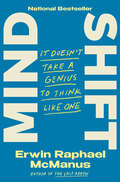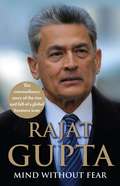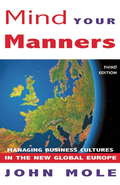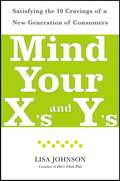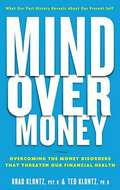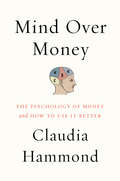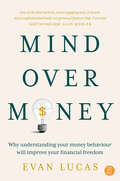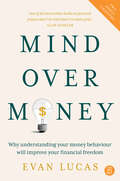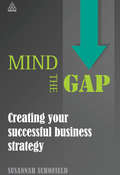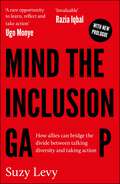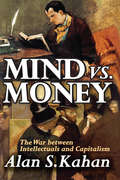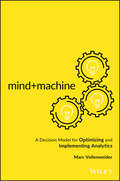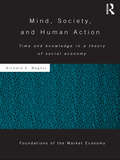- Table View
- List View
Mind Shift: It Doesn't Take a Genius to Think Like One
by Erwin Raphael McManusNATIONAL BESTSELLER • Mental toughness, mental clarity, and mental health all have one thing in common: The journey begins in your mind. In this radical guide, the award-winning author of The Last Arrow illuminates a surprising path toward personal fulfillment and optimal performance.&“Erwin McManus is the most brilliant thinker I&’ve ever met.&”—fourteen-time bestselling author Jon GordonThroughout his thirty years of work as a mindset expert and leadership coach, Erwin Raphael McManus has been obsessed with these questions: Why do some people succeed despite having all the odds stacked against them? How do others achieve the unthinkable, only to watch their lives slip away? Are there mental structures for failure and success?McManus has come to realize that too many of us have &“near-life&” experiences. We almost pursue our dreams. We almost make the decision that changes everything. We are always one choice away. If we want to live without regret, we need to make a mind shift—trading beliefs that limit our potential for ones that help us move toward optimal performance and pursue the success of being fully alive. We must move from a life of obligation to a life of intention.In Mind Shift, McManus brings together twelve mental frameworks that have helped some of the most accomplished people on earth create internal structures of success. Among them:• You have to choose between acceptance and uniqueness. If you are addicted to affirmation, you will become what others want you to be rather than who you were created to become.• You don&’t need an audience. It&’s what you do in private that makes you who you are.• Talent is a hallucinogen. It will make you believe that hard work and discipline are for everyone else.Sharing experiences from entrepreneurs, artists, professional athletes, and his own career, McManus shows us how to transform our thinking—and, in turn, transform our lives.
Mind Tools for Managers: 100 Ways to be a Better Boss
by Julian Birkinshaw James ManktelowThe manager's must-have guide to excelling in all aspects of the job Mind Tools for Managers helps new and experienced leaders develop the skills they need to be more effective in everything they do. It brings together the 100 most important leadership skills—as voted for by 15,000 managers and professionals worldwide—into a single volume, providing an easy-access solutions manual for people wanting to be the best manager they can be. Each chapter details a related group of skills, providing links to additional resources as needed, plus the tools you need to put ideas into practice. Read beginning-to-end, this guide provides a crash course on the essential skills of any effective manager; used as a reference, its clear organization allows you to find the solution you need quickly and easily. Success in a leadership position comes from results, and results come from the effective coordination of often competing needs: your organization, your client, your team, and your projects. These all demand time, attention, and energy, and keeping everything running smoothly while making the important decisions is a lot to handle. This book shows you how to manage it all, and manage it well, with practical wisdom and expert guidance. Build your ideal team and keep them motivated Make better decisions and boost your strategy game Manage both time and stress to get more done with less Master effective communication, facilitate innovation, and much more Managers wear many hats and often operate under a tremendously diverse set of job duties. Delegation, prioritization, strategy, decision making, communication, problem solving, creativity, time management, project management and stress management are all part of your domain. Mind Tools for Managers helps you take control and get the best out of your team, your time, and yourself.
Mind Without Fear: The Extraordinary Story of the Rise and Fall of a Global Business Icon
by Rajat Gupta&“A propulsive narrative filled with boldfaced names from business and politics. At times, it is a dishy score settler.&”—The New York Times For nine years, Rajat Gupta led McKinsey & Co.—the first foreign-born person to head the world&’s most influential management consultancy. He was also the driving force behind major initiatives such as the Indian School of Business and the Public Health Foundation of India. A globally respected figure, he sat on the boards of distinguished philanthropic institutions such as the Gates Foundation and the Global Fund to Fight AIDS, Tuberculosis and Malaria, and corporations, including Goldman Sachs, American Airlines, and Procter & Gamble. In 2011, to the shock of the international business community, Gupta was arrested and charged with insider trading. Against the backdrop of public rage and recrimination that followed the financial crisis, he was found guilty and sentenced to two years in jail. Throughout his trial and imprisonment, Gupta has fought the charges and maintains his innocence to this day. In these pages, Gupta recalls his unlikely rise from orphan to immigrant to international icon as well as his dramatic fall from grace. He writes movingly about his childhood losses, reflects on the challenges he faced as a student and young executive in the United States, and offers a rare inside glimpse into the elite and secretive culture of McKinsey, &“the Firm.&” And for the first time, he tells his side of the story in the scandal that destroyed his career and reputation. Candid, compelling, and poignant, Gupta&’s memoir is much more than a courtroom drama; it is an extraordinary tale of human resilience and personal growth.
Mind Your Manners
by John MoleUnderstanding the nature of cultural diversity is one thing-managing it day-to-day is quite another! When doing business internationally, culture shock-and sometimes culture clash-is unavoidable. John Mole's Mind Your Manners: Managing Business Cultures in the New Global Europe is a comprehensive guide that explores cultural aspects of dozens of individual European countries as they relate to global business. Now in a fully expanded and updated third edition, Mind Your Manners includes every countriy-from the Baltics to the Balkans-applying for membership to the European Union, the world's biggest global market, and many others.Based on interviews, surveys, and workshops with over a thousand managers (of fifty nationalities), Mind Your Manners describes Europe's extraordinary political, economic, and social changes and their effects on the way we work together. New chapters on diversity, change, body language, and negotiation identify the key elements that shape the business and cultural environment of the continent, and Euroquizzes will test your knowledge and demonstrate the broad cultural spectrum of European nations. More than a mere catalog, Mind Your Manners is a must-read for anyone who intends to succeed in the European Union.
Mind Your Manners: How to Be Your Best Self in Any Situation
by Sara Jane HoFounder of a global etiquette school and star of her own Netflix series Sara Jane Ho teaches readers how to thrive socially in a variety of situations, in person and online. Etiquette, Sara Jane says, is the glue that holds society together. Humans are social creatures, after all—we need connection to survive. But with global cultures in flux and the post-pandemic digital age, shadow epidemics of anxiety and loneliness are on the rise. Plus, the old rules of &“decorum&” don&’t match the times. Amidst all this withdrawal and change, social growth can feel out of reach. How do we leave the comfort of our homes, step away from our screens, and interact face to face? How do we create genuine bonds with people we&’ve just met, and how do we maintain those ties throughout our lives? Even the most resilient social butterflies among us face sticky situations—from accidentally-sent invites to unruly work and family encounters—any advice would help. In her signature cheeky yet pragmatic style, Sara Jane Ho imparts a lifetime&’s worth of lessons, pro-tips, and FAQs on social and digital etiquette across the five main microcultures in our lives: Friendship & Social Life, Work, Dating & Relationships, Family, and Food & Travel. From jumping everyday hurdles to discerning unspoken, cross-cultural cues, Mind Your Manners helps us feel the joy and transformation of social fluency—that deep comfort that comes from connection, inclusion, and presenting our best self in any situation.
Mind Your Manners: Managing Business Cultures in the New Global Europe
by John MolePraised by Business Week as 'invaluable political and psychological profiles of each nationality...a wonderfully entertaining view of others as well a ourselves' and named a Financial Times Business Book of the Year, Mind Your Manners has become a 50,000-copy bestseller and the standard guide to European business cultures for over a decade. Now in a fully expanded and updated third edition, this practical guide contains a further fifteen country chapters including all the additional countries - from the Baltics to the Balkans - becoming a members of the European Union, the world's biggest global market. This major new edition comprehensively covers no fewer than thirty-three different business cultures including non-EU Norway, Switzerland, Russia and America.
Mind Your Manners: Managing Business Cultures in the New Global Europe
by John MolePraised by Business Week as 'invaluable political and psychological profiles of each nationality...a wonderfully entertaining view of others as well a ourselves' and named a Financial Times Business Book of the Year, Mind Your Manners has become a 50,000-copy bestseller and the standard guide to European business cultures for over a decade. Now in a fully expanded and updated third edition, this practical guide contains a further fifteen country chapters including all the additional countries - from the Baltics to the Balkans - becoming a members of the European Union, the world's biggest global market. This major new edition comprehensively covers no fewer than thirty-three different business cultures including non-EU Norway, Switzerland, Russia and America.
Mind Your Own Business: A Maverick's Guide to Business, Leadership and Life
by Sidney Harman“The maverick’s way of conducting business forswears the leader as commanding general; it rejects the practice of top-down, authoritative command. Rather, it proposes the leader as catalyst, conscience, and inspirer . . . The true leader sees his job as setting an environment in which new ideas can emerge that neither he nor any other individual anticipated. That leap of imagination, that moment of genuine creativity, can only be inspired by a leader who encourages exploration and shows a willingness to consider a totally new approach.” --from Mind Your Own BusinessThe corporate misdeeds of self-serving executives during the high-octane economy of the 1990s have forced many people to rethink the qualities that make a strong leader. For sixty years, Sidney Harman, the chairman and CEO of the world’s premier manufacturer of high-end audio equipment, has stood apart from the crowd, building his business the old-fashioned way, by satisfying customers and, in doing so, making a healthy profit. His refreshingly employee-centric, bottoms-up approach to business is the secret of Harman International’s continuing success. In Mind Your Own Business, Harman shares his visionary ideas about leadership, providing a welcome contrast to the bad behavior of business leaders recently dominating the news. Harman focuses on creating a culture of personal responsibility throughout his company. He likens his top management team to a jazz quartet that listens to and improvises with one another to create harmony. He stresses the need to do more for workers at every level because employees are the company’s most valuable asset. At Harman International, he has established in-house classrooms to teach English, basic math, health, and music, and encourages his employees to pursue their potential. Now a hale and healthy eighty-five, Harman thinks that “an idea a day” is more important than the proverbial apple and that the key to a long life is a restless curiosity. In the bestselling tradition of Max DePree’s Leadership Is an Art, Mind Your Own Business is a frank, no-nonsense guide for those who want to bring strength, vitality, and values to their businesses—and to their lives.
Mind Your Own Mortgage: The Wise Homeowner's Guide to Choosing, Managing, and Paying Off Your Mortgage
by Robert J. BernabéLEARN TO SHOP FOR AND MANAGE YOUR MORTGAGE UNTIL YOU HAVE ELIMINATED IT—ONCE AND FOR ALL!Mind Your Own Mortgage empowers homeowners to shop for a mortgage as if it were a commodity—as easy as buying a gallon of gas—and enables them to eliminate their mortgage debt by revealing inside information used to keep them enslaved to the mortgage industry. Mind Your Own Mortgage changes the game—putting you in charge: Shop with confidence—an exclusive system helps you make decisions based on the best price Identify slick sales gimmicks and lender manipulationRefinance only when it makes sense for you—not for the mortgage companyEliminate your mortgage in record time—so your retirement years include retirementA SOUND MORTGAGE = A SOUND ECONOMYStocked with compelling real-life scenarios, budgeting tips, and handy financial tools, Mind Your Own Mortgage is a timely wake-up call for homeowners and a candid decree that the American dream is still possible—if we dramatically rethink the way we finance our homes.IT’S TIME TO MIND YOUR OWN MORTGAGE.“Whether you’re getting a new mortgage, refinancing an old one, or dealing with the mortgage you have already, you won’t find a better mortgage coach than my friend, Rob Bernabé.” —Mary Hunt, personal finance expert, best-selling author, and CEO of Debt-Proof Living“Finally, consumers have what they need to hold any mortgage provider accountable.” ?R. Jarret Lilien, founder and managing partner of Bendigo Partners and former president and COO of E*Trade Financial
Mind Your X's and Y's
by Lisa Johnson Cheri HansonToday's 18-to-40-year-olds make for a notoriously elusive group of consumers: they're savvy, sophisticated, and particular. They're all but immune to traditional advertising and have an instinctive sense of quality and fair pricing. Inundated with choices, they are drawn to brands that satisfy not just what they need, but what they crave. At the same time, these consumers are spending money like it's going out of style. Generation X has firmly refuted its slacker reputation and is nearing the height of its earning potential. Generation Y has more buying power than any previous generation of teens and twentysomethings. But how to win their attention and loyalty? In "Mind Your X's and Y's", Lisa Johnson proves that the buying habits of 18-to-40-year-olds can be anticipated. Johnson, coauthor of "Don't Think Pink" and a leading marketing consultant, pinpoints the new rules of engagement for this Connected Generation. Based on her own and others' groundbreaking research, she looks into the heart of the Gen X and Y psyche to identify its ten core cravings -- for adventure, for high-concept design, for new families and social networks, and for personal storytelling, to name a few. This revolutionary book is packed with fascinating case studies of established and breakaway brands from every major industry, interviews with dozens of maverick thinkers and hundreds of consumers, and numerous revealing statistics. Johnson analyzes the scope of each craving to determine how it drives specific buying behaviors and offers relevant data that illustrate its impact. Mind Your X's and Y's equips anyone who wants to reach these consumers -- brand managers and their advertising, online, creative, packaging, events, and promotions teams; small-business owners and their marketing staff; advertising agencies and specialists -- with the know-how to transform market research into profitable strategies. Members of Generations X and Y are the most coveted and hard-to-reach consumers in the marketplace. Mind Your X's and Y's is a master class in how to create compelling brands for this Connected Generation.
Mind Your X's and Y's
by Lisa JohnsonToday's 18-to-40-year-olds make for a notoriously elusive group of consumers: they're savvy, sophisticated, and particular. They're all but immune to traditional advertising and have an instinctive sense of quality and fair pricing. Inundated with choices, they are drawn to brands that satisfy not just what they need, but what they crave. At the same time, these consumers are spending money like it's going out of style. Generation X has firmly refuted its slacker reputation and is nearing the height of its earning potential. Generation Y has more buying power than any previous generation of teens and twentysomethings. But how to win their attention and loyalty? In Mind Your X's and Y's, Lisa Johnson proves that the buying habits of 18-to-40-year-olds can be anticipated. Johnson, coauthor of Don't Think Pink and a leading marketing consultant, pinpoints the new rules of engagement for this Connected Generation. Based on her own and others' groundbreaking research, she looks into the heart of the Gen X and Y psyche to identify its ten core cravings -- for adventure, for high-concept design, for new families and social networks, and for personal storytelling, to name a few. This revolutionary book is packed with fascinating case studies of established and breakaway brands from every major industry, interviews with dozens of maverick thinkers and hundreds of consumers, and numerous revealing statistics. Johnson analyzes the scope of each craving to determine how it drives specific buying behaviors and offers relevant data that illustrate its impact. Mind Your X's and Y's equips anyone who wants to reach these consumers -- brand managers and their advertising, online, creative, packaging, events, and promotions teams; small-business owners and their marketing staff; advertising agencies and specialists -- with the know-how to transform market research into profitable strategies. Members of Generations X and Y are the most coveted and hard-to-reach consumers in the marketplace. Mind Your X's and Y's is a master class in how to create compelling brands for this Connected Generation.
Mind of a Survivor: What the wild has taught me about survival and success
by Megan Hine***Shortlisted for the Great Outdoors Book of the Year***Surviving in the wild takes a great deal of strength. Often faced with frozen tundra, sweltering deserts, humid jungles, perilous mountains and fast-flowing rivers, Megan Hine is no stranger to perilous conditions. Whilst leading expeditions and bushcraft survival courses and in her work on television shows such as Bear Gryll's Mission Survive and Running Wild, she has explored the corners of the globe in pursuit of adventure.Faced with the toughest of conditions: bad weather; lack of food and being in the presence of predators, is the ultimate test of character and often the biggest challenge to overcome is in the head. In these situations, the human brain is simultaneously the greatest asset and biggest liability. Not everyone is suited to the great outdoors and when danger calls many aren't as well-equipped to survive, no amount of top of the range kit will save you if you don't have the right frame of mind. Here Megan Hine examines the human ability and instinct for survival, showing us how others have developed the attitudes and attributes to thrive in the most dangerous situations, and how those same attitudes and attributes help them confront problems and obstacles at work and at home. Being chased through the jungle by armed opium farm guards, abseiling past bears and lighting fires with tampons, Megan has seen and done it all. In Mind of a Survivor she takes you along for a series of life-and-death adventures and shows you what happens to people when they are pushed to their limits. Inspirational rather than instructional, Megan examines the human ability and instinct for survival sharing the life tools that she uses and showing how they can as easily be applied to more domestic everyday life - from careers to relationships, from overcoming adversity to decision making. Filled with her own experiences, Mind of a Survivor is packed full of adventure and can help people survive in any situation and cope with whatever life throws at them.
Mind of a Survivor: What the wild has taught me about survival and success
by Megan Hine***Shortlisted for the Great Outdoors Book of the Year***Surviving in the wild takes a great deal of strength. Often faced with frozen tundra, sweltering deserts, humid jungles, perilous mountains and fast-flowing rivers, Megan Hine is no stranger to perilous conditions. Whilst leading expeditions and bushcraft survival courses and in her work on television shows such as Bear Gryll's Mission Survive and Running Wild, she has explored the corners of the globe in pursuit of adventure.Faced with the toughest of conditions: bad weather; lack of food and being in the presence of predators, is the ultimate test of character and often the biggest challenge to overcome is in the head. In these situations, the human brain is simultaneously the greatest asset and biggest liability. Not everyone is suited to the great outdoors and when danger calls many aren't as well-equipped to survive, no amount of top of the range kit will save you if you don't have the right frame of mind. Here Megan Hine examines the human ability and instinct for survival, showing us how others have developed the attitudes and attributes to thrive in the most dangerous situations, and how those same attitudes and attributes help them confront problems and obstacles at work and at home. Being chased through the jungle by armed opium farm guards, abseiling past bears and lighting fires with tampons, Megan has seen and done it all. In Mind of a Survivor she takes you along for a series of life-and-death adventures and shows you what happens to people when they are pushed to their limits. Inspirational rather than instructional, Megan examines the human ability and instinct for survival sharing the life tools that she uses and showing how they can as easily be applied to more domestic everyday life - from careers to relationships, from overcoming adversity to decision making. Filled with her own experiences, Mind of a Survivor is packed full of adventure and can help people survive in any situation and cope with whatever life throws at them.
Mind over Matter and Artificial Intelligence: Building Employee Mental Fitness for Organisational Success
by Vidya S. AthotaThis book explores mind over matter in a digital age and presents the importance of continued transformation of the mind to promote humane Artificial Intelligence for greater good. In doing so, it focuses on the organizational and managerial practices that are critical in creating an environment that supports mindset and organizational growth. The digital age is significantly impacting employees and organizations and steering billions of people around the world. Artificial Intelligence has created a whole new paradigm with a revolution loftier than all the industrial revolutions and the innovations of the past millennia combined. We are either headed towards restoring humanity back to the “Imago Dei”, where creative powers are unleashed in human freedom, or advocating selective breeding and “survival of the fittest”.
Mind over Money: Overcoming the Money Disorders That Threaten Our Financial Health
by Brad Klontz Ted KlontzDo you overspend? Undersave? Keep secrets about money from a spouse or family member? Are you anxious about dealing with your finances? If so, you are not alone. Let's face it–just about all of have complicated, if not downright dysfunctional, relationships with money. As Drs. Brad and Ted Klontz, a father and son team of pioneers in the emerging field of financial psychology explain, our disordered relationships with money aren’t our fault. They don’t stem from a lack of knowledge or a failure of will. Instead, they are a product of subconscious beliefs and thought patterns, rooted in our childhoods, that are so deeply ingrained in us, they shape the way we deal with money our entire adult lives. But we are not powerless. By looking deep into ourselves and our pasts, we can learn to recognize these negative and self-defeating patterns of thinking, and replace them with better, healthier ones. Drawing on their decades of experience helping patients resolve their troubling issues with money, the Klontzes and describe the twelve most common “money disorders” - like financial infidelity, money avoidance, compulsive shopping, financial enabling, and more — and explain how we can learn to identify them, understand their root causes, and ultimately overcome them. So whether you want to learn how to make better financial decision, have more open communication with your spouse or kids about the family finances, or simply be better equipped to deal with the challenges of these tough economic times, this book will help you repair your dysfunctional relationship with money and live a healthier financial life.
Mind over Money: The Psychology of Money and How to Use It Better
by Claudia HammondThe acclaimed author of Time Warped tackles the very latest research in the fields of neuroscience, psychology, and biology to provide a fresh, fascinating, and thought-provoking look at our relationship with money--perfect for fans of Dan Ariely and Freakonomics.We know we need money and we often want more of it, but we don't always think about the way it affects our minds and our emotions, skews our perceptions and even changes the way we behave. Award-winning BBC Radio 4 host Claudia Hammond delves into the surprising psychology of money to show us that our relationship with the stuff is more complex than we might think. Drawing on the latest research in psychology, neuroscience and behavioural economics, she draws an anatomy of the power it holds over us. She also reveals some simple and effective tricks that will help you use and save money better--from how being grumpy can stop you getting ripped off to why you should opt for the more expensive pain relief and why you should never offer to pay your friends for favours. An eye-opening and entertaining investigation into the power money holds over us, Mind over Money will change the way you view the cash in your wallet and the figures in your bank account forever. Mind over Money is an invaluable resource for anyone fascinated by the dynamics of money and for those wishing to learn how to maximize its power and greatest benefit.
Mind over Money: Why understanding your money behaviour will improve your financial freedom
by Evan LucasUnderstand how your thinking drives your money behavior to master your finances and make better financial decisions.There is limitless financial information in our modern-day, connected world. We can find stats, facts, investing approaches, wealth creation hacks and new ways to wealth (think cryptocurrencies). But leading economist and market analyst Evan Lucas believes we should cut out the external noise and look at ourselves first. What drives our behavior and attitude to money? This fascinating book explores the things people do to overcome their money habits and looks to instill tips on how we can make better money decisions just by acknowledging our own learned behaviors.
Mind over Money: Why understanding your money behaviour will improve your financial freedom
by Evan LucasMaster your mindset and make better financial decisions.What drives our behaviour and attitude to money? All too often we ignore logic and make decisions around money that we know aren' t entirely rational. That' s because money isn' t just about finances – it' s deeply tied up with our emotions, our learned behaviours and our biases.We are all different in the way we use money: some of us are savers, some spenders, some risk-takers or investors. Mind over Money will help you understand your money personality and how your thinking drives your money behaviour. It will teach you how to make better money decisions by acknowledging your own learned behaviours and working with your strengths to meet your financial goals.Mind over Money is a life-changing book. Featuring two bonus chapters, this new edition will help you get even clearer on what you want from life and your money so you can master your finances, improve your financial freedom and have the lifestyle you desire.
Mind the Gap
by Susannah SchofieldEvery business needs to accurately assess its own strengths and weaknesses against their competitors, direct or indirect, in order to create a winning strategy. Mind the Gap introduces the author's tried and tested strategic model, the Dice Matrix, which will enable you to do just that. This simple business tool will allow you to stress test your weaknesses, compare your performance against customers' perception and also highlight the strengths you provide as a business. You can input your own set of criteria to gain a valuable, tailored overview of the necessary actions to achieve success. Using examples and evidence collected from over 100 experts from a variety of business sizes and types, the author provides groundbreaking insights into key issues and challenges, from customer needs to market perception. Mind the Gap provides the essential tools required for any Business Owner, Director or Manager to implement a detailed gap analysis of their business and to create a strategic plan for long-lasting growth and success.
Mind the Inclusion Gap: How Allies Can Bridge the Divide Between Talking Diversity and Taking Action
by Suzy LevyFrom the US to Europe and beyond, diversity and inclusion efforts are increasingly being caught in the crossfire of a culture war. As the backlash against ‘DEI’ grows, fairness and dignity are being reframed as divisive – rather than just smart business. So how did we get here, and what can we do about it? Very few of us are skilled in inclusion, hoping it will be enough to be ‘nice’. However, this optimistic attitude can turn would-be allies into passive bystanders. This book is for anyone who wants to support equality: inside are tools and practical guidance to help navigate complexity, challenge complacency and take meaningful action.
Mind the Tech Gap: Addressing the Conflicts between IT and Security Teams
by Nikki RobinsonIT and cybersecurity teams have had a long-standing battle between functionality and security. But why? To understand where the problem lies, this book will explore the different job functions, goals, relationships, and other factors that may impact how IT and cybersecurity teams interact. With different levels of budget, competing goals, and a history of lack of communication, there is a lot of work to do to bring these teams together. Empathy and emotional intelligence are common phenomena discussed in leadership books, so why not at the practitioner level? Technical teams are constantly juggling projects, engineering tasks, risk management activities, security configurations, remediating audit findings, and the list goes on. Understanding how psychology and human factors engineering practices can improve both IT and cybersecurity teams can positively impact those relationships, as well as strengthen both functionality and security. There is no reason to have these teams at odds or competing for their own team’s mission; align the missions, and align the teams. The goal is to identify the problems in your own team or organization and apply the principles within to improve how teams communicate, collaborate, and compromise. Each organization will have its own unique challenges but following the question guide will help to identify other technical gaps horizontally or vertically.
Mind vs. Money: The War Between Intellectuals and Capitalism
by Alan KahanFor the past 150 years, Western intellectuals have trumpeted contempt for capitalism and capitalists. They have written novels, plays, and manifestos to demonstrate the evils of the economic system in which they live. Dislike and contempt for the bourgeoisie, the middle classes, industry, and commerce have been a prominent trait of leading Western writers and artists. Mind vs. Money is an analytical history of how and why so many intellectuals have opposed capitalism. It is also an argument for how this opposition can be tempered.Historically, intellectuals have expressed their rejection of capitalism through many different movements, including nationalism, anti-Semitism, socialism, fascism, communism, and the 1960s counterculture. Hostility to capitalism takes new forms today. The anti-globalization, Green, communitarian, and New Age movements are all examples. Intellectuals give such movements the legitimacy and leadership they would otherwise lack. What unites radical intellectuals of the nineteenth century, communists and fascists of the twentieth, and anti-globalization protestors of the twenty-first, along with many other intellectuals not associated with these movements, is their rejection of capitalism. Kahan argues that intellectuals are a permanently alienated elite in capitalist societies.In myriad forms, and on many fronts, the battle between Mind and Money continues today. Anti-Americanism is one of them. Americans like to see their country as a beacon of freedom and prosperity. But in the eyes of many European and American intellectuals, when America is identified with capitalism, it is transformed from moral beacon into the "Great Satan." This is just one of the issues Mind vs. Money explores. The conflict between Mind and Money is the great, unresolved conflict of modern society. To end it, we must first understand it.
Mind+Machine: A Decision Model for Optimizing and Implementing Analytics
by Marc VollenweiderCut through information overload to make better decisions faster Success relies on making the correct decisions at the appropriate time, which is only possible if the decision maker has the necessary insights in a suitable format. Mind+Machine is the guide to getting the right insights in the right format at the right time to the right person. Designed to show decision makers how to get the most out of every level of data analytics, this book explores the extraordinary potential to be found in a model where human ingenuity and skill are supported with cutting-edge tools, including automations. The marriage of the perceptive power of the human brain with the benefits of automation is essential because mind or machine alone cannot handle the complexities of modern analytics. Only when the two come together with structure and purpose to solve a problem are goals achieved. With various stakeholders in data analytics having their own take on what is important, it can be challenging for a business leader to create such a structure. This book provides a blueprint for decision makers, helping them ask the right questions, understand the answers, and ensure an approach to analytics that properly supports organizational growth. Discover how to: Harness the power of insightful minds and the speed of analytics technology Understand the demands and claims of various analytics stakeholders Focus on the right data and automate the right processes · Navigate decisions with confidence in a fast-paced world The Mind+Machine model streamlines analytics workflows and refines the never-ending flood of incoming data into useful insights. Thus, Mind+Machine equips you to take on the big decisions and win.
Mind, Society, and Human Action: Time and Knowledge in a Theory of Social-Economy (Routledge Foundations Of The Market Economy Ser.)
by Richard E. WagnerEconomics originated as a branch of the humane studies that was concerned with trying to understand how some societies flourish while others stagnate, and also how once-flourishing societies could come to stagnate. Over the major part of the 20th century, however, economists mostly turned away from these humane and societal concerns by importing mechanistic ideas from 19th century physics. This book seeks to show how that original humane and social focus can be renewed. The many particular topics the book examines can be traced to two central ideas. Firstly, that economic theory, like physics, requires two distinct theoretical frameworks. One treats qualities that are invariant across time and place; this is the domain of equilibrium theory. The other treats the internal generation of change in societies through entrepreneurial action that continually transforms the ecology of enterprises that constitutes a society. Secondly, economic theory is treated as a genuine social science and not a science of rationality writ large. The book also explores ways in which life in society is understood differently once economics is treated as a social science. The book is much of the hyper-formality that comprises economic theory these days fails to make reasonable contact with reality. It will be of interest to sociologists, political scientists, and researchers in law, public policy, Austrian economics, evolutionary economics, institutional economics and political economy.
MindFit: How to Create a Kickass Workforce to Achieve Long-term Business Excellence
by Kristopher G. Harold Alexis Ee-Khem Aw John K. WilliamsThe impacts of workplace stress and burnout include low productivity and profitability, rampant presenteeism and absenteeism, alarming workplace safety performance and workers compensation claims, poor quality assurance, high negative staff turnover and even, sometimes, work-related suicide. How do you solve such complex problems when the root cause is often nebulous or emotionally-charged? <p><p> Workplace mental fitness is the answer. <p> MindFit introduces Link:Flow:Grow, a breakthrough organisational design and development toolkit that puts workplace mental fitness first. This practical, field-tested solution empowers your workforce to: <p> ● skyrocket productivity and increase revenue <p> ● improve workplace safety and reduce workers compensation figures <p> ● reduce negative staff turnover and restore employee engagement <p> ● transform organisational culture and address other chronic business challenges. <p> MindFit introduces a transformative business management paradigm backed by mental fitness stretches, relatable stories, practical insights and handy checklists to empower your Company, your Team and your Self. It’s idealism made practical, complex made cheeky and education made entertaining. Don’t leave work without it!
